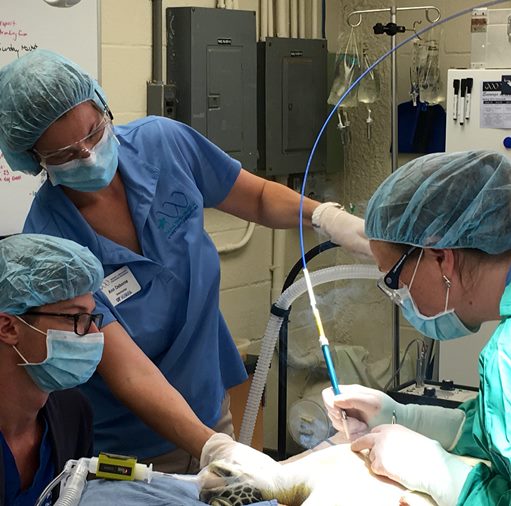 The Whitney Laboratory for Marine Bioscience
The Whitney Laboratory for Marine Bioscience

The University of Florida Whitney Laboratory Sea Turtle Hospital is now using advanced carbon dioxide laser technology in the treatment of its sea turtle patients that are infected with the Fibropapilloma virus (FP). The FP virus creates internal and external tumors on the sea turtle that inhibit normal functioning such as mobility, eating and vision. While the cause of the virus is unclear, the current form of treatment is the removal of the external growths once the sea turtle is healthy enough to undergo surgery. Now at the Sea Turtle Hospital, a carbon dioxide laser is used during surgery to remove the tumors, thanks to a generous donation from a sea turtle enthusiast and community member. Since there are very few grants available to sustain programs such as these, donations to the hospital are incredibly important.
The first surgery at Whitney Laboratory using the laser treatment took place on April 11, 2016. Cisco Kid, a juvenile green sea turtle found stranded on Hammock Beach in Palm Coast, Fla., on Jan. 29, 2016, was the first patient to undergo surgery using the new laser to remove his/her tumors. Before undergoing surgery, Cisco Kid had to gain weight, have a high enough red cell count, and be strong enough to withstand anesthesia. Cisco Kid responded well to treatment, and after only a few months at the hospital, he/she was ready for surgery.
During surgery, the laser is used to shrink or remove the external tumors on the sea turtle. A laser is the most effective tool for this procedure because it reduces bleeding, is less painful and shortens recovery time for the sea turtle. Once out of surgery, the sea turtle is placed on antibiotics and pain management medication to keep him/her comfortable and free of infection.
It took a few days after surgery for Cisco Kid to start eating on his/her own, but now he/she is eating well. Cisco Kid’s incision sites will take approximately one month to heal. Once the surgical sites are healed and there is no tumor regrowth, then Cisco Kid will be ready to be released back into the wild. Since the FP virus occurs naturally in the wild, there is no reason to keep Cisco Kid for longer than rehabilitation requires.
FP has been reported in growing numbers around the world but has particular prevalence in the local sea turtle population. Scientists and citizens alike have seen sea turtles with this disease in local waters and feel that a multi-disciplinary, scientific and community-based approach to action is needed to find a cure for the virus. The hospital not only treats the sea turtles, but it also has a dedicated person on staff to research the sea turtles with FP in an effort to advance the understanding of the virus, its life-cycle, transmission and effect on marine animal health. Additional research conducted looks at the role climate change plays in disease expansion, differences between healthy and infected immune systems, differences between the virus-causing microorganisms and healthy ones, and chemical changes in the local waters caused by human influence. By understanding the cause of marine diseases, it is hopeful that the researchers at the UF Whitney Laboratory can help direct conservation efforts related to overall ecosystem health.